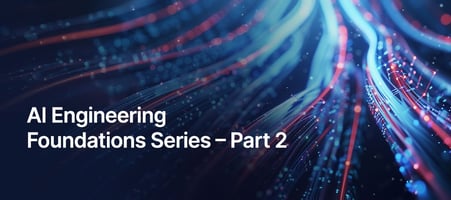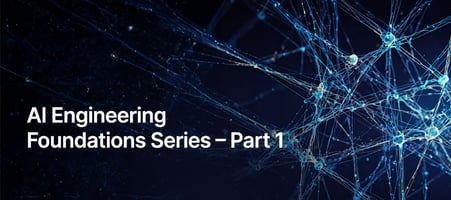Beyond Prompts: How Knowledge Engineering and Data Engineering Build Smarter, Grounded AI Agents
.webp?width=941&height=492&name=Covasant_Blog_Banner_With_Author%20(1).webp)
The promise of Agentic AI is captivating as autonomous systems are capable of understanding complex requests, reasoning through challenges, and taking intelligent actions. Imagine a scenario in which AI responds to queries and also solves problems, from orchestrating complex business processes to providing expert-level customer support.
Yet, many early attempts at building sophisticated AI agents fall into a subtle but significant trap due to the over-reliance on prompt engineering. You embed all the necessary contexts, business rules, and reasoning steps directly into an LLM prompt, but it is not effective. While powerful for initial exploration, this approach often leads to unscalable and unreliable AI agents.
The solution? A strategic shift towards knowledge engineering, underpinned by robust data engineering for LLMs, to create a dedicated "brain trust" for AI agents and build a resilient Agentic AI framework for long-term scalability and reliability.
The Limits of Pure Prompt Engineering for Agentic AI
Large Language Models (LLMs) are incredible for language understanding and generation, but they are not inherent knowledge bases or deterministic rule engines. When you push them to act solely through prompts, you may encounter significant limitations, such as:
-
Context Window Crunch: LLMs have finite memory. Trying to stuff an entire enterprise's policies, product catalogs, and intricate business rules into a prompt quickly hits token limits, forcing the LLM to "forget" crucial information.
For example, an agent designed to process insurance claims might need to know hundreds of policy clauses, regional regulations, and historical claim data. Putting all of this information into every prompt is impossible.
-
Hallucination Hazard: Asking an LLM to derive complex, multi-step reasoning or recall specific, static facts purely from its training data increases the risk of generating plausible but incorrect or fabricated information. LLMs are built to predict the next token, not to guarantee factual accuracy or adherence to rules.
For example, if you ask an agent, "What's our return policy for opened electronics bought over 30 days ago?" and this rule isn't explicitly provided, then the LLM might confidently invent a policy based on its general knowledge, which could contradict actual company guidelines.
-
Maintenance & Scalability Nightmares: Business rules evolve. If your pricing logic or compliance regulations change, updating dozens of intricate prompts across multiple agents is a time-consuming, error-prone, and expensive endeavor.
-
Cost & Latency: Longer, more complex prompts consume more tokens, leading to higher API costs and slower response times, hindering real-time agent performance.
These challenges illustrate why solely relying on prompting agents to "figure it out" is akin to asking a brilliant but improvisational actor to manage the complex logistics of a global supply chain without any manuals or databases.
Introducing the Knowledge-Engineered Data Store: The Agent's Brain Trust
For Agentic AI to move beyond demos and into reliable enterprise applications, agents need a dependable source of truth. This is where a knowledge-engineered data store comes in, a specialized, multi-faceted repository designed to provide structured, relevant, and accurate information. This "brain trust" typically comprises:
-
Relational Databases (DB): It is the backbone for structured, dynamic, and transactional data. It includes customer profiles, order history, current inventory levels, employee records, and real-time operational data. An Agent's "Facts & Figures" Tool: When an agent needs to know "What is Customer X's last order status?" or "How many widgets are in stock?" it queries the database.
-
Knowledge Graphs (KG): The ultimate tool for representing complex relationships, taxonomies, and explicit business rules. A KG connects disparate pieces of information semantically, allowing for sophisticated traversal and rule application. An Agent's "How Things Connect & Why" Tool: This is where rules like "If a customer is a 'premium member' AND order value is more than $500, THEN offer 'express shipping' for free" is encoded. It explicitly maps entities, attributes, and their relationships.
-
Vector Stores: Essential for handling unstructured data. Documents like policy manuals, FAQs, technical specifications, and internal wikis are broken into chunks and transformed into numerical embeddings (vectors) that capture their semantic meaning. This enables Retrieval-Augmented Generation (RAG). An Agent's "Relevant Context" Tool: When an agent encounters a question like "What's the eligibility for a corporate wellness program?" it can perform a semantic search in the vector store to retrieve the most relevant sections of the wellness policy document. This setup transforms the LLM's role from "reasoner/fact-finder" to "orchestrator/synthesizer."
The LLM gives importance to understanding intent, breaking down tasks, and generating natural language, while the knowledge store provides the grounded, verifiable information needed to make informed decisions.
Data Engineering: The Unsung Hero Building the Knowledge Foundation
A knowledge-engineered data store must be meticulously built, maintained, and optimized by data engineers. They are the architects and builders of the very foundation upon which reliable Agentic AI stands. Effective data engineering for LLMs ensures scalability, observability, and governance for every intelligent system.
Here’s how data engineering plays a pivotal role in each component:
Data Ingestion & ETL/ELT Pipelines:
- Connecting Diverse Sources: Data engineers build robust connectors to pull data from a myriad of enterprise systems (CRMs, ERPs, APIs, streaming data, flat files, documents).
- Cleaning & Transformation: Raw enterprise data is often messy. Data engineers craft complex ETL/ELT jobs to clean, standardize, de-duplicate, and transform this data into a format suitable for each part of the knowledge store. This might involve resolving inconsistent spellings, handling missing values, or normalizing schemas.
- Ensuring Freshness: For agents dealing with real-time operations (e.g., customer support, logistics), data engineers implement streaming pipelines or scheduled jobs to ensure the knowledge store is always up to date.
Knowledge Graph Construction:
- Triplification & Schema Mapping: Data engineers play a crucial role in translating structured or semi-structured data from databases or documents into triples (Subject-Predicate-Object) that form the core of a Knowledge Graph. This involves sophisticated schema mapping and ontology design to accurately represent entities, attributes, and their relationships.
- Rule Encoding: They work closely with domain experts to encode business rules and relationships directly into the KG, making them machine-readable and queryable.
Example: Mapping "Customer" entity to "has_tier" relationship to "Premium" node, which then "entitles_to" "Free_Express_Shipping" rule.
Vector Store Preparation (RAG Pipeline):
- Intelligent Chunking: Data engineers develop strategies to break down vast documents (e.g., a 200-page employee handbook) into semantically coherent "chunks" that are optimal for retrieval.
- Embedding Generation & Management: They manage the process of feeding these chunks into embedding models to generate numerical vectors and ensure these vectors are efficiently stored and indexed in the vector database for rapid semantic search.
- Version Control: Ensuring that the vector store is updated as source documents change, maintaining consistency.
Infrastructure, Scalability & Performance:
- Architectural Design: Data engineers select and integrate the right blend of technologies (e.g., PostgreSQL, Neo4j, Pinecone) to create a scalable, high-performance data architecture.
- Optimization: They tune database queries, graph traversal algorithms, and vector search indices to ensure agents can retrieve information within milliseconds, directly impacting an agent's response time.
- Monitoring & Observability: Implementing robust monitoring tools to track data pipeline health, data quality, and store performance, ensuring any issues are quickly identified and resolved before they impact agent operations.
The Synergistic Outcome: Smarter, More Reliable Agents
By investing in knowledge engineering, powered by diligent data engineering, we unlock a new era for Agentic AI.
- Reduced Hallucinations & Increased Accuracy: Agents now operate on verifiable facts and explicit rules, drastically reducing the risk of generating incorrect information.
- Enhanced Trust & Compliance: Especially vital in regulated industries (finance, healthcare), agents can provide responses grounded in auditable, up-to-date knowledge bases.
- Maintainability & Scalability: Business logic resides in its own dedicated, manageable layers (KG, DB), rather than being scattered across numerous prompts. Updates are centralized and efficient.
- Explainability & Auditability: It becomes easier to trace an agent's decision or response back to the specific data points and rules it retrieved from the knowledge store.
- Cost-Effectiveness: LLMs are used for what they do best, language understanding and generation, with smaller, focused prompts, leading to lower token usage and faster processing.
Conclusion: The Foundation for Reliable and Scalable Agentic AI
The path to truly powerful and reliable Agentic AI isn't solely about bigger LLMs or cleverer prompts. It's about building intelligent systems on a foundation of well-structured, accessible, and high-quality knowledge.
For AI architects and developers, this means embracing knowledge engineering for AI systems as a core discipline and recognizing data engineering as its indispensable partner. By prioritizing the meticulous construction and governance of a knowledge-engineered data store, you can move beyond the limitations of prompt engineering and unlock the full, grounded potential of enterprise-grade Agentic AI systems.




